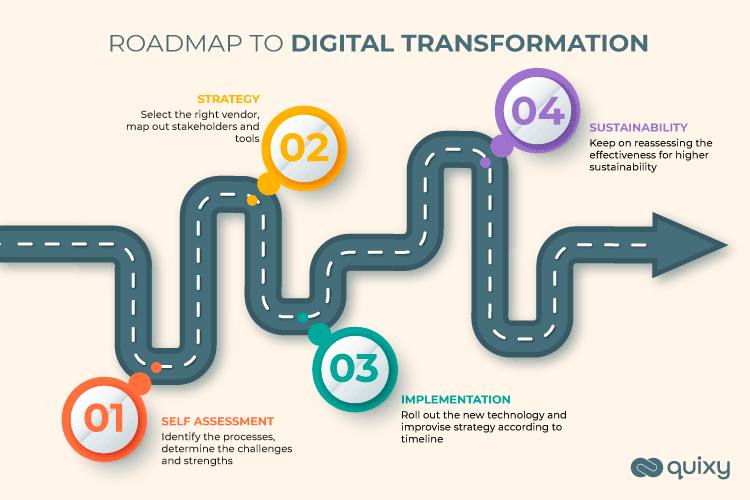
Digital transformation is something every CEO, employee, and layman has heard of- LinkedIn posts, news articles, and blogs cannot stop raving about the importance of digital transformation for your business. But let’s be honest, how many of us know what digital transformation entails? Is it a change in your business model or how you operate? The truth is that the digital transformation roadmap is both of those AND a cultural shift.
What is Digital Transformation?
The truth is that there isn’t a one-size-fits-all definition, and Digital transformation can look different for different companies. Success lies in analyzing the operations of a business, identifying opportunities for innovation, and having a strong bias for action that promotes experimentation and implementation of new ideas to improve customer experience. This zeal to change is often hindered by the hesitancy of organizations unwilling to walk away from their comfort zone- outdated systems, redundant technologies, and slow processes. This leads to stagnation, which is a recipe for disaster waiting to unfurl its wrath.
Digital transformation emphasizes three pillars of change- leveraging technology to enhance business capabilities, building operational efficiencies, and constantly improving customer experience.
Change is the only constant
When the Greek philosopher Heraclitus said that change is the only constant, he wasn’t thinking of companies in today’s market looking to transform themselves digitally, but the truth remains. In a highly disruptive market, it’s essential for companies to constantly reinvent themselves, boost operational efficiencies, and have a competitive edge over others. This involves being prepared for a cultural change- an affinity to challenge the status quo, getting comfortable with innovation and experimentation, and embracing failure if needed. According to Gartner, 91% of businesses are engaged in some form of digital initiative, and 87% of senior business leaders say digitalization is a priority.
Also Read: Digital Transformation in Insurance
Change means movement. Movement means friction.
The road map for digital transformation comes with its own set of hurdles. From management that rejects change to employees unwilling to upskill and learn something different, friction comes from all angles.
“Don’t tell me how to run my business.”
Upper management can reject change in business processes and be opposed to developing new systems and methods. Leaders’ passivity in the organization can make the company lag behind in its journey to digital transformation.
You must spend money to make money
Very few organizations understand the payoff that investing in digital transformation can bring about. A common reason companies cite for being opposed to digital transformation is budgetary constraints, but very few realize the long-term benefits it can bring.

Beginning with an end in mind
Often, digital transformation is associated with tremendous confusion because organizations embark on this journey without a clear objective in mind. Melissa Swift, who leads Korn Ferry’s Digital Advisory for North America and Global Accounts, says that “digital” is a problem because it means different things to different people. “Say ‘digital’ to one person, and they think of going paperless; another might think of data analytics and artificial intelligence; another might picture Agile teams, and yet another might think of open-plan offices,” she says.
Old isn’t always gold
Outdated systems hinder growth. While it is crucial to embrace innovation, it is also essential to do away with obsolete systems and legacy technologies. The time and money spent on updating old systems can be diverted to building innovative systems that will yield long-term results and trickle down to better value add to customers.
Indeed, digitally transforming a business isn’t easy, but a clear objective helps smooth the transition.
Some common objectives of Digital Transformation
1. A change in the business model
Your current business model may not fetch the expected results, especially in a post-pandemic era. You want to change or diversify your business model to adapt to current trends. When the pandemic hit, many companies had to move from being retail-first to being digital-first. Once you know that your business model needs to adapt to current changes, you’ll be able to map the road ahead.
2. A reduction in operational costs
All businesses have a profit motive, and cutting costs is an essential part of this. The usage of legacy technologies may keep the employees comfortable. Still, rapid innovation and transitions to new-age tech can become a game-changer when competing with newer startups disrupting the market. Essential resources utilized in maintaining these old systems can be deployed in innovation and experimentation.
3. An improvement in customer experience
Customer experience can never be replicated, which makes it the hardest to master. Digital transformation can aid in standardizing and reducing human error pertaining to customer experience. From simple feedback loops to common queries that can be answered through bots, digital transformation sits at the forefront of excellent customer experience.
How can I tell if my company has succeeded in digital transformation?
No one shoe fits all. It would be not very careful to cite metrics that can vouch for the success of your organization’s digital transformation journey. And thus, it’s essential to personalize KPIs based on the business and functionality.
Many KPIs point toward the success of a business, but very few genuinely indicate the success of digital transformation. It makes good business sense to assign weightage to each KPI in terms of importance. For example, a retail first clothing store looking to move online can measure its success in many ways—namely, its shopping cart abandon rate, site traffic, or even the net promoter score. The secret to an accurate analysis lies in understanding the business’s stage, considering that the store has just built an online presence. Site traffic as a KPI may carry more weightage than the other KPIs.
What are the factors that contribute to the success of digital transformation?
Robust objectives
Having a clear end goal helps streamline your business’s digital transformation. Understanding the business benefits that digital transformation can bring about, the customer value that it can add, and the role that the various stakeholders play in the journey significantly contributes to the overall success of your company.
Involved stakeholders
People can make or break an organization. It’s imperative to ensure that digital transformation is not just a change in business operations but is also a cultural change. This involves higher management making active decisions to innovate, upskill and experiment, and employees being trained adequately to meet challenges as and when needed. Clearly defining expectations from various stakeholders aids in a smooth transition.
Simple processes
A large part of digital transformation is acquiring new, savvy systems. But true success lies in simplicity and making the existing processes more robust. Instead of wasting precious resources on figuring out completely new techniques, it makes more sense to map existing business processes.
Also Read: Digital Transformation Demystified !!
Strategic Digital Transformation Roadmap
Your roadmap to digital transformation may look completely different from someone else’s, but it’s essential to keep the vital ingredients constant.

Self-assessment
Identifying the business’s current strengths and weaknesses to enable digital transformation is crucial to building a robust objective that is to be achieved. Assessing the present scenario is key to making changes to move forward.
Strategy
Identifying relevant technology is critical- it can make or break your organization. Automating workflows may seem trivial, but it can make all the difference. For example, choosing no-code digital Deployment platforms to automate workflows is much simpler, less costly, and more efficient when compared to hiring talent specifically for the maintenance of relevant tech.
Also Read: How Quixy Can Help You with Digital Transformation?
Implementation
Successful digital transformation is a cultural change, just like a business change. It’s imperative to train employees to adapt to this change and provide adequate resources to upskill.
Sustainability
Constant reassessment of projects is necessary if a business truly wants to gain a competitive edge. Digital transformation isn’t a task but an ongoing process requiring constant innovation, supervision, and feedback.
Also Read: The Conundrum of Digitization, Digitalization, and Digital Transformation
Digital Transformation Strategy vs Digital Transformation Roadmap
While Digital Transformation Strategy and Digital Transformation Roadmap are 2 crucial components of a successful digital transformation, they serve distinct purposes within the overall process.
Digital Transformation Strategy
- Focus: Why and What
- Purpose: Defines the overall direction and goals of the digital transformation.
- Key Questions:
- What is the desired future state of the organization?
- What are the key business objectives to be achieved through digital transformation?
- What are the core competencies and capabilities needed to succeed?
- What are the potential risks and challenges?
- Outcome: A high-level blueprint outlining the organization’s digital vision and strategic priorities.
Digital Transformation Roadmap
- Focus: How and When
- Purpose: Outlines the specific steps, timelines, and resources required to execute the strategy.
- Key Questions:
- What are the specific projects and initiatives needed to achieve the strategic goals?
- What is the timeline for each project?
- What are the required resources (budget, personnel, technology)?
- What are the key performance indicators (KPIs) to measure progress?
- Outcome: A detailed plan with actionable steps, milestones, and timelines to guide the implementation of the strategy.
Relationship Between the Two
- Strategy Informs the Roadmap: The strategy provides the overarching direction, while the roadmap details the tactical steps to get there.
- Roadmap Supports the Strategy: The roadmap ensures that the strategic goals are broken down into actionable tasks and timelines.
- Iterative Process: Both the strategy and roadmap may need to be adjusted as the organization learns and adapts to changing circumstances.
In essence:
- Strategy is the “big picture” vision.
- The roadmap is the detailed plan to execute that vision.
By effectively combining a well-defined digital transformation strategy with a detailed roadmap, organizations can increase their chances of successfully navigating the complex landscape of digital transformation and achieving their desired outcomes.
Also Read: 11 Most Mind-Blowing Examples of Digital Transformation
Tips for Deploying Your Digital Transformation Roadmap
A well-crafted digital transformation roadmap is essential, but its successful deployment is equally crucial. Here are some tips to ensure a smooth and effective implementation:
1. Secure Strong Leadership and Sponsorship
- Executive Buy-in: Ensure top-level support to allocate necessary resources and overcome organizational hurdles.
- Dedicated Leadership: Assign a dedicated team to oversee the transformation, providing clear direction and accountability.
2. Foster a Culture of Innovation and Change
- Employee Engagement: Involve employees in the process, encouraging feedback and participation.
- Training and Development: Provide necessary training to upskill employees and equip them with new digital skills.
- Change Management Strategy: Implement a comprehensive change management plan to minimize resistance and maximize adoption.
3. Prioritize and Phase
- Phased Approach: Break down the transformation into smaller, manageable phases to avoid overwhelming the organization.
- Prioritize Initiatives: Focus on high-impact initiatives that align with strategic goals.
- Agile Methodology: Consider using agile methodologies to adapt to changing circumstances and deliver value quickly.
4. Data-Driven Decision Making
- Data Analytics: Leverage data analytics to identify trends, optimize processes, and make informed decisions.
- Data Governance: Establish strong data governance practices to ensure data quality, security, and privacy.
5. Robust Technology Infrastructure
- Scalable Infrastructure: Invest in a scalable and flexible IT infrastructure to support future growth.
- Cybersecurity: Implement robust cybersecurity measures to protect sensitive data and systems.
- Cloud Adoption: Consider cloud-based solutions to improve scalability, cost-efficiency, and agility.
6. Continuous Monitoring and Evaluation
- Key Performance Indicators (KPIs): Define and track KPIs to measure progress and identify areas for improvement.
- Regular Reviews: Conduct regular reviews of the roadmap to adapt to changing business needs and emerging technologies.
- Feedback Loops: Gather feedback from stakeholders to refine the strategy and implementation.
7. Partner with the Right Experts
- External Expertise: Consider partnering with external consultants to bring specialized knowledge and experience.
- Vendor Selection: Choose reliable technology partners who can provide the necessary support and solutions.
By following these tips, you can increase the chances of a successful digital transformation. Remember, it’s a journey, not a destination. Stay adaptable, embrace change, and continuously learn and evolve.
Examples of Digital Transformation Roadmaps
Here are some real-world examples of big brands that have successfully implemented digital transformation:
Netflix
- Transformation: From a DVD rental company to a global streaming giant.
- Key strategies:
- Content streaming platform
- Personalized recommendations
- Original content production
Amazon
- Transformation: From an online bookstore to a multi-billion-dollar e-commerce and cloud services company.
- Key strategies:
- E-commerce platform
- Cloud computing services (AWS)
- AI and machine learning for personalized recommendations and logistics optimization
Nike
- Transformation: From a traditional sportswear brand to a digital-first company.
- Key strategies:
- E-commerce platform
- Mobile app with personalized product recommendations and loyalty programs
- Data-driven insights for product design and marketing
Starbucks
- Transformation: From a coffee shop to a tech-enabled experience.
- Key strategies:
- Mobile app for ordering and payment
- Loyalty program and personalized offers
- AI-powered drive-thru and in-store experiences
Walmart
- Transformation: From a traditional retailer to an e-commerce powerhouse.
- Key strategies:
- E-commerce platform
- Online grocery pickup and delivery
- AI-powered inventory management and supply chain optimization
These companies have successfully leveraged digital technologies to improve customer experience, increase efficiency, and drive growth. They serve as excellent examples of how digital transformation can be a powerful tool for businesses of all sizes.
Also Read: How Quixy Can Help You with Digital Transformation?
Creating a Digital Transformation Roadmap: A Step-by-Step Guide
A well-structured digital transformation roadmap is crucial for guiding your organization through its digital journey. Here’s a step-by-step approach for Digital Transformation:
1. Define Your Vision and Goals
- Clear Vision: Articulate an inspiring vision for your organization’s digital future.
- Strategic Goals: Set specific, measurable, achievable, relevant, and time-bound (SMART) goals aligned with your vision.
- Identify KPIs: Determine key performance indicators (KPIs) to track progress and measure success.
2. Assess Your Current State
- SWOT Analysis: Conduct a comprehensive SWOT analysis to identify strengths, weaknesses, opportunities, and threats.
- Digital Maturity Assessment: Evaluate your organization’s current digital maturity level.
- Identify Gaps: Pinpoint areas where digital transformation can add value and improve efficiency.
3. Develop a Digital Strategy
- Prioritize Initiatives: Select high-impact initiatives that align with your strategic goals.
- Resource Allocation: Allocate necessary resources, including budget, personnel, and technology.
- Timeline: Create a realistic timeline for each initiative, setting clear milestones.
4. Choose the Right Technologies
- Technology Selection: Identify technologies that will enable your digital transformation, such as cloud computing, AI, IoT, and big data.
- Vendor Selection: Choose reliable technology partners to support your initiatives.
- Integration: Plan for seamless integration of new technologies with existing systems.
5. Foster a Digital Culture
- Leadership Buy-in: Ensure strong leadership support and involvement.
- Employee Training: Provide training and development opportunities to upskill employees.
- Change Management: Implement effective change management strategies to minimize resistance.
6. Data Strategy
- Data Governance: Establish data governance policies and procedures.
- Data Security: Implement robust security measures to protect sensitive data.
- Data Analytics: Leverage data analytics to gain valuable insights and make informed decisions.
7. Continuous Monitoring and Evaluation
- Performance Tracking: Monitor key performance indicators (KPIs) to measure progress.
- Regular Reviews: Conduct regular reviews of your roadmap to adapt to changing circumstances.
- Iterative Approach: Be prepared to adjust your digital business strategy as needed based on feedback and emerging trends.
Remember, a successful digital transformation is a journey, not a destination. By following these steps and staying agile, you can position your organization for long-term success in the digital age.
Drive Your Digital Transformation with Quixy
Quixy is a powerful no-code platform that can help you accelerate your digital transformation journey. By empowering both technical and non-technical users to build custom applications, workflows, and automation using ERP Modernization Plan.Quixy enables you to:
Key Benefits of Using Quixy:
- Rapid Application Development: Quickly build and deploy applications without the need for extensive coding.
- Process Automation: Automate repetitive tasks and streamline workflows to increase efficiency.
- Data-Driven Decisions: Make informed decisions with real-time data insights.
- Enhanced Collaboration: Improve teamwork and communication with seamless collaboration features.
- Increased Agility: Adapt to changing business needs with ease.
How Quixy Can Help You:
- Streamline Operations:
- Automate routine tasks and reduce manual errors.
- Optimize business processes to improve efficiency and productivity.
- Implement real-time tracking and monitoring of operations.
- Improve Customer Experience:
- Build personalized customer experiences with tailored solutions.
- Enable efficient customer support and issue resolution.
- Collect and analyze customer feedback to drive continuous improvement.
- Empower Your Workforce:
- Provide employees with the tools they need to work smarter, not harder.
- Foster a culture of innovation and creativity.
- Empower teams to take ownership of their work and drive results.
Real-World Use Cases:
Organizations across various industries have successfully implemented Quixy to address a wide range of challenges:
- Healthcare: Patient management, appointment scheduling, medical records management.
- Finance: Loan processing, expense management, financial reporting.
- Retail: Inventory management, sales forecasting, customer relationship management.
- Manufacturing: Production planning, quality control, supply chain management.
- Education: Student enrollment, course management, faculty workload management.
Conclusion
It’s impossible to think of digital transformation without considering the difficult transitionary period of change. But digital transformation is less about technology and more about organizational change management and culture- when all the stakeholders related to the business get on board to reinvent old systems, adopt new technology and take the initiative to simplify workflows, the effect can be spectacular.
When companies execute projects with agility, they can deliver high-value solutions to their customers, delight them more accessible and faster, and save costs while they’re at it. There is no right or wrong way to transform a business digitally, and that’s its beauty. The key is to understand business goals, find ways to constantly innovate, and never shy away from adopting technology to build operational efficiencies. To stay relevant in a digital-first world, it’s essential to become digital and move away from legacy technologies. After all, even a caterpillar has to come out of its cocoon to become a butterfly.
Frequently Asked Questions(FAQs)
Q. What is the digital transformation framework?
A digital transformation framework is a structured approach that guides an organization through integrating digital technologies into
its operations. It serves as a roadmap, outlining the steps, strategies, and best practices to achieve desired outcomes
Q. How can frameworks prioritize digital initiatives?
Frameworks prioritize initiatives by aligning them with strategic goals, assessing risks, allocating resources, mapping dependencies, and analyzing ROI.
Q. How can data drive digital transformation securely?
Data can drive digital transformation securely through data governance, robust security measures, privacy compliance, data quality, and ethical AI usage.
Q. How Do You Structure Digital Transformation?
A digital transformation is structured by:
1. Defining vision and goals
2. Assessing the current state
3. Developing a digital strategy
4. Implementing technologies
5. Fostering a digital culture
6. Monitoring and evaluating
Login
Please login to comment
0 Comments
Oldest
















